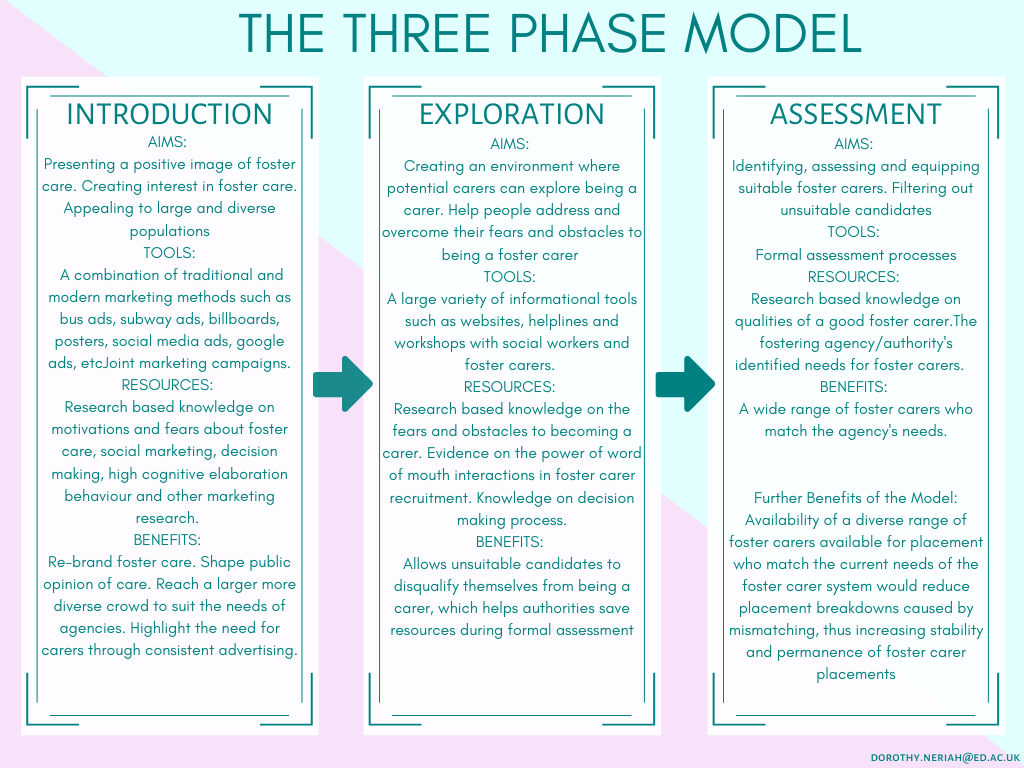In this guest article, Dorothy Neriah, a PhD student at the University of Edinburgh, details a Three-Phase Model to support organisations rethink how they practise and evaluate the recruitment of foster carers.
Listen to her speak about the research on Iriss.fm.
The Three-Phase Model
The Three-Phase Model is a synthesis of current research and practice in a new way to give a better understanding of a complex process. Each phase has its own objectives, draws from different resources, and has its own results. The three-phase model aims at using the right resources, having the right expectations and achieving the right results at the appropriate stages. By understanding these, local authorities and independent agencies can adjust their recruitment process and distribute resources accordingly.

1. Introduction phase
A lot of recruitment methods fall under phase one. These include advertisements on buses, radio, tv and social media, billboards, posters and other marketing material. These recruitment methods have a wide reach and help raise awareness about fostering. It should be done consistently and clearly. One of the major criticisms of current recruitment methods is how confusing and haphazardly it seems to be done. Social marketing helps us understand how the framing of advertisements can affect results. Advertising for foster carer recruitment tends to follow trends in advertising for charities. However, the decision-making process involved in donating money is quite different from the decision to become a foster carer. Therefore, the framing of advertisements for recruitment of carers must be uniquely suited to fulfil its purpose. In Australia, Melanie Randle has made great strides in proving the application of social marketing to foster carer recruitment. With a decade of experience researching the area, her work has been successfully implemented in Australia.
The first step in social marketing involves having a target audience for the advertisements. The aim of proper recruitment practice should not just be to have 'any' foster carers but it should attract and register the 'right' foster carers. These are determined by the needs of the agency or authority. Some might need culturally diverse carers, others might need carers for older children, while others might need carers for children with disabilities. These needs should all be taken into consideration when framing advertisements to attract the right people. One case study in the US shows how using Spanish language in ads and strategically placing them in places frequented by Spanish speakers, helped meet the rising need for Spanish speaking foster carers.
Having attracted the attention of the right people through targeting and well-framed advertisements, phase one methods should have an appropriate call to action. A call to action is the next step that you want the audience to take. In current practice, the call to action tends to either be missing, or too ambitious by asking the carer to apply to foster. The call to action should instead invite people to explore more about fostering and whether it is for them. It should lead to an appropriate phase two method.
Phase one marketing serves as an introduction to fostering. When done well, it can give fostering a positive brand identity by shaping the public opinion of foster care. Through targeted marketing it can help meet the specific need of agencies and local authorities. Through consistency it can build awareness of foster care by keeping it at the forefront of people’s minds. Although expensive, phase one marketing is worth it because having a positive image of fostering will not only help recruitment, but also improve the fostering experience for both fostered children and foster carers who often experience stigma as a result of the negative public opinion of fostering.
2. Exploration phase
Research has shown that people can consider fostering for several years. This could be because they are waiting for the right circumstances to start fostering or because they are unsure. Numerous studies have also revealed the antecedents to fostering. It is during the exploration phase that potential foster carer’s fears are addressed. People in the exploration phase want to find out more about fostering. They need access to information in different forms and different platforms as they consider fostering. Phase two methods include passive methods such as website information pages, and dialogic methods such as Facebook groups, helplines and information sessions. This phase should offer open honest interactions, giving potential carers a real understanding of fostering. It should also provide spaces for them to hear first-hand from foster carers and to have their questions answered. Word-of-mouth has been found to be a powerful tool in the recruitment of carers. Current carers and social workers are a strong resource during this phase.
Methods in this phase are often evaluated for their ability to lead to registration numbers, but the strength of this phase is in its ability to help people filter themselves out as they decide whether fostering is for them. For example, an information session would not be considered a failure if most of the attendees did not go on to apply to be carers. It’s all about getting the right carers. There are three potential results of any exploration phase; they decide fostering is not for them, they apply to foster, or they decide to pursue more information. All of these are successful results because it reduces the resources spent on assessing unsuitable candidates in phase three. Recruiters should be responsive to potential carers and offer them a variety of avenues to go through the exploration phase.
3. Assessment phase
The final phase of recruitment is a highly rigorous internal process unique to each fostering agency. It is aimed at filtering out unsuitable candidates. Research on the motivations of foster carers and characteristics of successful foster carers is a vital resource to this phase. Some studies have even shown that the type of motivation can affect stability of placements, as well as the types of placements the carers will take. This phase is often criticised for being lengthy and can be quite intimidating to potential carers. Research has also shown that local authorities can be slow in responding to applications. Recruiters should take note of these potential pitfalls and guide applicants through the process efficiently and with care. Recruiters should also be aware of the needs of the agency; it's not about getting any carers, but the right type of carers. The agency needs identified in phase one targeting should also be used during the assessment phase. A successful phase three method should be effective and efficient in filtering out unsuitable candidates while also identifying, assessing and training the right type of carer that matches the agency’s needs.
Having a wider variety of foster carers to choose from would help improve the fostering experience for fostered children, as well as foster carers by improving matching which reduces instability. The three-phase model provides a better understanding of the recruitment process in light of people’s decision-making patterns, thus, giving recruiters a better understanding of what methods to use, how to use them and when to use them. It would allow for better distribution of resources and more defined results.
Contact the author: dorothy.neriah@ed.ac.uk

